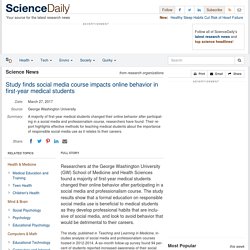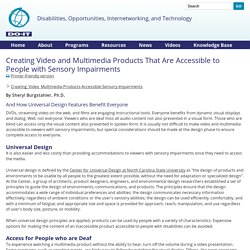

Apa. Ethics Guidelines for Internet-Mediated Research (2017) BPS Code of Human Research Ethics (2nd edition, 2014) Study suggests high school students hold negative views of online education. Most college-bound high school students are concerned about the quality of online education, but many say they are open to the idea of taking some of their courses online, a new study shows.

But the most recent issue of the studentPOLL, published by the standardized test provider ACT and the consulting firm Art & Science Group, suggests incoming college students still believe they will pursue higher education the traditional way: by attending most of their courses in person. Among the students surveyed for the studentPOLL, 85 percent of respondents said they wanted to take a majority of their courses in person, but only 6 percent said they were open to the idea of taking half, most or all of them online. About one-third (37 percent) said they could see themselves taking a handful of online courses, while 9 percent were undecided.
The survey responses for the studentPOLL were gathered in February 2015 from students who took the ACT the previous fall. Richard A. Study finds social media course impacts online behavior in first-year medical students. Researchers at the George Washington University (GW) School of Medicine and Health Sciences found a majority of first-year medical students changed their online behavior after participating in a social media and professionalism course.

The study results show that a formal education on responsible social media use is beneficial to medical students as they develop professional habits that are inclusive of social media, and look to avoid behavior that would be detrimental to their careers. Preschoolers' story comprehension similar for print and digital books. The content of a children's book -- not its form as a print book or a digital book -- predicts how well children understand a story, finds a new study by NYU Steinhardt School of Culture, Education, and Human Development.

The findings, presented on May 1 at the American Educational Research Association's annual meeting in San Antonio, suggest that both digital stories and reading storybooks in person present opportunities for learning vocabulary and comprehension. Given the rich language in books, reading aloud storybooks is an important activity for engaging children and developing their early literacy skills. It has been less than clear what role digital storybooks -- which have grown in popularity in recent years -- play in this learning. However, there has been increasing concern regarding children's ability to comprehend stories in this form. Research has found that children learn better through interactions with a live person than with video presentations. How Pokémon GO can help students build stronger communication skills. Technology continues to change the way students learn and engage with their peers, parents and community.

That is why Emily Howell, an assistant professor in Iowa State University's School of Education, is working with teachers to develop new ways to incorporate digital tools in the classroom, including playing games such as Pokémon GO. The focus of Howell's work is two-fold -- to give students equitable access to technology and help them build multimodal communication skills. That means not only using technology to consume information or replace traditional classroom tools, but experimenting with new forms of communication, she said. Digital games improve mental health, educational outcomes of Syrian refugee children. Digital games can effectively teach refugee children much-needed skills -- including a new language, cognitive skills, and coding -- while also improving their mental health, finds research by New York University, the City University of New York, and Turkey's Bahcesehir University.

The study of Syrian refugee children, presented by researchers on June 6 at BAU International University in Washington, DC, suggests that digital games can be a cost-efficient and scalable approach to meeting the educational and psychological needs of refugee children. "It is our hope that this study shows that even with limited resources, and even when there are language barriers, we can make a difference in the lives of children through leveraging technology," said Selcuk Sirin, J.K. Online assessment could improve math marks of deaf learners. Online mathematics assessment (OMA) could help improve the mathematics performance of deaf and hard-of-hearing learners in South Africa.

This is one of the key findings of a new study at Stellenbosch University (SU). "OMAs can help deaf and hard-of-hearing learners to understand difficult mathematical concepts and provide them with equal opportunities to do well in formal mathematics assessments," says Dr Nolan Damon who is a mathematics teacher and ? Blended-learning designer and trainer from Worcester. Social media helps students learn scientific argumentation better: Students who took part in social media program learned better than peers who did not. Adults often bemoan the amount of time young people spend staring at a screen and browsing social media.

Tablets can teach kids to solve physical puzzles. Researchers confirm that when 4-6 year old children learn how to solve a puzzle using a touchscreen tablet, they can then apply this learning to the same puzzle in the physical world.

Multimedia – Accessibility Toolkit – 2nd Edition. In this section, we provide recommendations to guide your inclusion of accessible multimedia content.

The term multimedia refers to a variety of ways, or media, used to communicate information, such as videos, audio, animations, and slideshows. File types used: MP3, MP4, PPT Before you can determine what you need to do to make media accessible, you must understand what is required for different types of multimedia. Consider the following questions: Does your multimedia resource include audio narration or instructions?
Add your own closed captions - YouTube Help. Creating Video and Multimedia Products That Are Accessible to People with Sensory Impairments. And How Universal Design Features Benefit Everyone DVDs, streaming video on the web, and films are engaging instructional tools.

Everyone benefits from dynamic visual displays and dialog. Well, not everyone. Viewers who are deaf miss all audio content not also presented in a visual form. Those who are blind can access only the visual content also presented in spoken form. Universal Design It is also easier and less costly than providing accommodations to viewers with sensory impairments once they need to access the media. Universal design is defined by the Center for Universal Design at North Carolina State University as "the design of products and environments to be usable by all people to the greatest extent possible, without the need for adaptation or specialized design". Web Accessibility Initiative (WAI) For Review: XR Accessibility User Requirements (XAUR) Updated Draft.